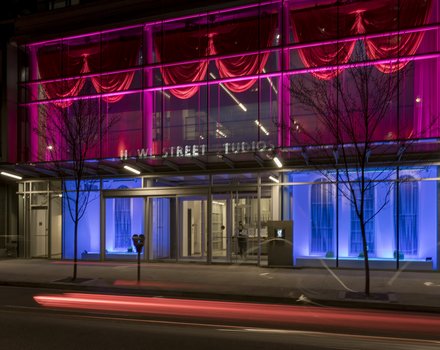

Jamie Hilder “Landmarks”, Jamie Hilder
C$ 0.00 Excl. tax
- File number: EXHI1058
...
Jamie Hilder’s solo exhibition, Landmarks, juxtaposes journalistic and scientific forms of writing to interrogate how data distance and alienate how we talk about violence. The exhibition consists of ten photogravure prints—etched from copper plates—and a modified seismograph. The framed prints contain red blocks of text, and seismic lines in black ink, printed on white rag paper. The seismograph’s drum is covered in black and white image-based archival pigment prints, while the seismograph’s needle records red lines, in real-time, throughout the duration of the exhibition. Each day, the image is changed, and new lines are recorded. The stark use of images and lines in black ink, combined with the red text and lines, resembles an alarmist headline.
Each of the intaglio prints in this exhibition presents generic descriptions of bombings, which are paired with their equivalent Richter magnitude scale reading. The explosions are all modern bombings that are large enough to register on the scale, thereby crossing over into the earth-moving category by toppling buildings and causing mass casualties. The force of the Beirut Marines Barracks explosion in 1983, for example, was the equivalent of an earthquake that would be rated at 4.7 on the Richter scale; the 1992 Miraflores bombing in Peru, carried out by Shining Path guerrillas, a 4.4; and, the 1995 Oklahoma City federal building bombing a 6.0. The effect of these equivalences is to force our understanding of cultural events into a mode of speech we have become accustomed to, that of objective measurement.
The explosions referenced in this exhibition can be thought of as landmarksbecause they indicate historical conflicts that are significant to a particular group of people, but they can also be thought of as landmarks because they created measurable impacts in physical time and space. By emphasizing the latter over the former, Hilder suggests that we, as a society, have developed a lexicon for assessing the effects of cruelty that lacks consideration of the unique context around moments of subjective trauma.
The instrumentalization of scientific figures tends to detract from the very topographies that need our attention most, a condition often witnessed in the role economic data plays in contemporary political discourse. Numbers related to jobs, tax rates, deficits, and wages obfuscate discussions of alienation, exploitation, precarity, and wealth disparity on various scales, which are themselves sites of persistent and common forms of violence.
When tragedy strikes, the results are often described in terms of socioeconomics; however, the explosions referenced in the etchings were perpetrated by civilians without specific state or economic associations. The fact that a small group of ordinary people could wreak such havoc, and produce such damage, is both a source of panic and an opportunity for further awareness. Yet it seems that we seldom consider how much power we as individuals actually have over one another, and the complex motivations that drive such instances of terror. We only remember the tumult, not the links to particular modes or groups of resistance.
The potential for rupture by everyday individuals is reinforced in the exhibition by the seismograph, which accompanies the prints, and is composed of a slowly rotating drum and needle armed with red ink. A seismometer, hidden in a plinth under the seismograph, observes the movement of people and cars inside and outside the gallery, and communicates these observations to the seismograph, which then records these movements as seismograms, superimposed onto semi-abstracted images that reference more general sites of violence in recent history, for example: the Alfred R. Murrah building in Oklahoma City (1995); the Brouwez House in the Democratic Republic of the Congo where Patrice Lumumba was tortured (1961); the riots in the banlieues of Paris (2005); the Bishopsgate bombing (1993); the favela raid in Rio de Janeiro where Manuel Moreira, Helio Oiticica’s friend and lover who was known as Cara de Cavalo (“Horse Face”), was murdered (1966); the Vancouver Olympic riots (2010); and, an image of the Site C dam proposal (2017). With so many seemingly unrelated references, Landmarks attempts to flatten acts of violence, meanwhile the exhibition’s interactive component suggests that we are all complicit in, and capable of, measurable impact.
Jamie Hilder is a Vancouver, Unceded Coast Salish Territories-based artist and writer whose work engages the intersections of economics and aesthetics. He has exhibited work internationally, and his critical writing has appeared in Fillip, Yishu Journal of Contemporary Chinese Art, Contemporary Literature, and Public Art Dialogue. His book Designed Words for a Designed World: The International Concrete Poetry Movement, 1955-1971 (McGill-Queens UP, 2016) addresses the effects that technologies of an emergent globalism had on the poetry of the mid-twentieth century. He is an instructor in Critical and Cultural Studies at Emily Carr University of Art and Design.
Recently viewed
-
 Favoriten
Add to cart
Favoriten
Add to cart
Jamie Hilder “Landmarks”, Jamie Hilder
C$ 0.00 Excl. tax


